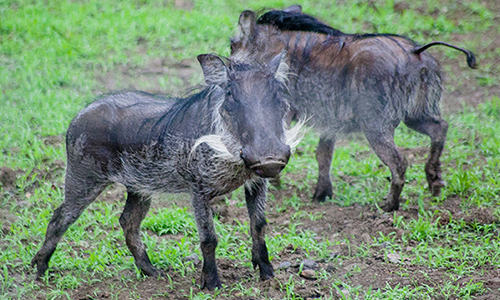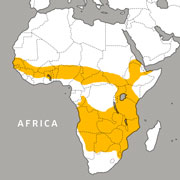Appearance:
The warthog’s head is large, they have manes running down their spine, and large upper tusks. Body hair is sparse, and their color is usually black or brown. Their tails are long and end in a tuft of hair. They’re distinguished by disproportionately large heads and “warts”—thick protective pads on both sides of the head. Warthogs are able to lower themselves close to the ground on their wrist joints, which are calloused and padded, to graze on short grasses. They're able to graze on short grasses by lowering themselves close to the ground on their wrist joints.
Size:
Common warthogs weigh 110 to 220 pounds with females being 20 to 50 pounds lighter than males. They have large upper tusks that are 255 to 635 millimeters long for males and 152 to 255 millimeters long for females.
Head and body length: 43 to 53 inches.
Shoulder height: approximately 30 inches
Diet:
Warthogs are primarily grazers but also feed on roots, berries, tree bark and occasionally carrion. They also eat their own dung and the dung of rhinos, African buffalos, waterbucks and francolins.
Reproduction:
Females frequently urinate to display readiness to mate. Females usually become fertile four to five months after the rainy season has ended, and they give birth during the dry season. A 170- to 175-day gestation period results in one to seven offspring (average of three). Warthogs reach sexual maturity at 18 to 20 months. Young are weaned at 21 weeks of age.
Behavior:
Warthogs’ social organization is matriarchal—boars only accompany soundings (groups) containing estrous females. Soundings consist of females and their young—usually about 18 members. Males disperse after 2 years of age and form bachelor groups. They’re primarily diurnal (active during the day) and they avoid nocturnal predators by sheltering in underground burrows at night. When alarmed, the warthog grunts or snorts, lowers its mane, flattens its ears and bolts for underground cover.
Warthogs have a very good sense of smell, which they use to communicate through scent markings. Their hearing is also strong, enabling them to listen for warning calls.
Habitat/Range:
Found outside forested areas in Africa, from Mauritania to Ethiopia and south to Namibia and eastern South Africa. Warthogs are found in moist and arid savannas. They avoid rainforest, deserts and high mountains.
Role in their habitat:
Warthogs are preyed upon mostly by lions, but also leopards and cheetahs. They have a mutualistic relationship with birds.
Life Expectancy:
Male: 11.2 years
Female: 12.3 years




